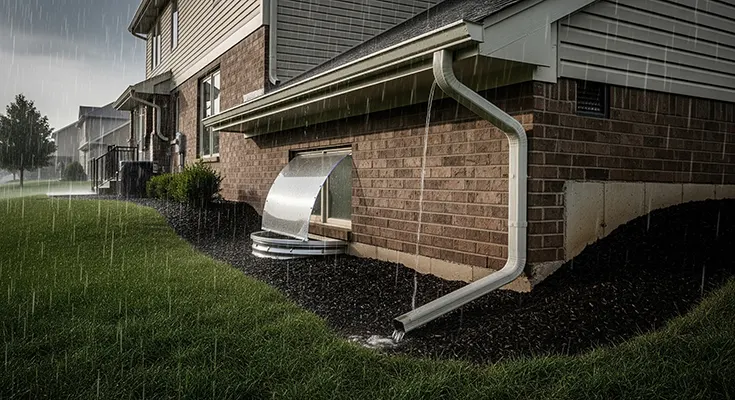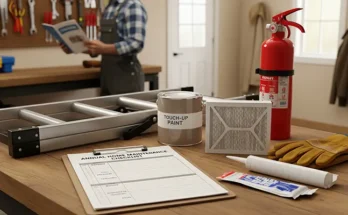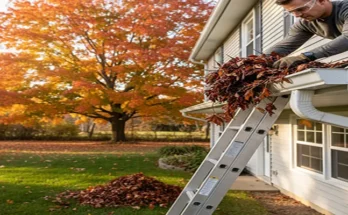Heavy rain is the number one enemy of a dry basement. Water damage not only ruins stored possessions and finished living spaces but can also lead to costly structural repairs and unhealthy mold growth. Protecting your basement requires a multi-faceted approach, focusing on managing water outside your home and sealing vulnerabilities inside.
1. Exterior Water Diversion (First Line of Defense)
The most effective way to prevent basement flooding is to ensure rainwater never pools near your foundation.
A. Gutters and Downspouts
- Clean Regularly: Clogged gutters are a primary cause of water damage, forcing water to spill over and pool right next to the foundation. Clean them at least twice a year.
- Extend Downspouts: Downspouts must discharge water at least 5 to 10 feet away from the foundation. Use extensions or splash blocks to ensure runoff is directed to a sloped area of the lawn.
B. Proper Grading and Landscaping
- Slope the Ground: The ground surrounding your home should slope away from the foundation. Ideally, the grade should drop at least 6 inches over the first 10 feet. Add compacted soil or clay to fill in any low areas near the house.
- Avoid Foundation Planting: Do not plant shrubs or garden beds right against the foundation, as they can trap moisture and their roots can compromise the concrete over time.
C. Window Wells
- Install Covers: Install securely fitted plastic or polycarbonate covers over basement window wells to prevent rainwater, leaves, and snow from accumulating.
- Ensure Drainage: Window wells should have a working drain filled with gravel that connects to the property’s perimeter drainage or sump system. Keep the drain free of debris.
2. Foundation and Wall Protection (Sealing Entry Points)
Water can penetrate concrete through hydrostatic pressure or small openings. Address these foundation vulnerabilities proactively.
- Seal Cracks: Inspect basement walls and floors annually. Use hydraulic cement or polyurethane caulk/epoxy injection kits to seal any visible cracks, no matter how small. Hydraulic cement expands as it dries, creating a watertight seal.
- Apply Waterproof Coatings: For minor moisture seepage, apply a waterproof masonry paint or a specialized silicate-based concrete sealer to the interior basement walls.
- Exterior Waterproofing (Professional): For persistent issues, professional exterior waterproofing involves excavating around the foundation to apply a waterproof membrane and install a drain tile (French drain) system that collects groundwater and directs it away from the foundation.
3. Interior Mitigation (Backup Systems)
These systems are vital for managing water that does manage to get past the exterior defenses.
- Install a Sump Pump: A sump pump is essential in any home prone to water accumulation. It sits in a pit in the basement floor, automatically pumping water out and away from the house when the water level rises.
- Add a Battery Backup: Heavy rain often coincides with power outages. A battery-backup sump pump is a critical failsafe to ensure your pump continues to run when the electricity fails.
- Consider a Backwater Valve: If you live in an area with a combined sewer system, heavy rain can overwhelm the public sewer, causing sewage to back up into your home. A backwater valve installed on your main sewer line prevents this flow reversal, protecting your basement from sewage-related flooding.
- Interior Drain Tile System: This system (similar to a French drain but installed inside the perimeter of the basement floor) collects water seeping up from under the floor or entering at the wall/floor joint and directs it to the sump pump.
Pre-Rainfall Checklist
Before a major storm hits, take these quick steps:
- Test the Sump Pump: Pour a bucket of water into the sump pit to ensure the float switch activates the pump and the water is successfully discharged.
- Clear Downspout Outlets: Make sure the end of your downspout extensions are free of leaves and debris.
- Clear Nearby Catch Basins: If there are storm drains or catch basins near your property, ensure they are not blocked by debris.
- Move Valuables: Elevate any items stored on the basement floor onto shelves or use waterproof storage bins.
- Reduce Water Use: During the heaviest rain, avoid heavy water usage (like running the dishwasher or washing machine) to prevent adding extra load to the already stressed sewer system.





